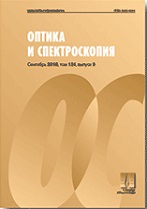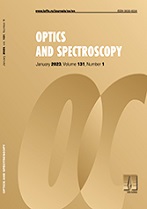|
This article is cited in 1 scientific paper (total in 1 paper)
Geometrical optics
Normal-incidence imaging spectrograph based on an aperiodic spherical grating for the vacuum spectral region
E. A. Vishnyakova, A. O. Kolesnikovab, E. N. Ragozinab, A. N. Shatokhinab
a Lebedev Physical Institute, Russian Academy of Sciences, 119991, Moscow, Russia
b Moscow Institute of Physics and Technology, 141707, Dolgoprudnyi, Russia
Abstract:
The possibility of astigmatism compensation in a wide wavelength range in normal incidence schemes based on a spherical diffraction grating with variable groove density has been considered. Two schemes imaging spectrographs with dimensions of about $1$ and $5$ m for the wavelength ranges $820$–$1690$ and $980$–$1520$ $\mathring{\mathrm{A}}$ that operate in the first external and first internal diffraction orders, respectively, have been calculated. It has been shown that the advantage of the external order of diffraction is a wide (more than an octave) spectral range at relatively compact sizes of the device. Schemes operating in internal orders of diffraction have better imaging characteristics, but large dimensions of the device are required to maintain the width of the wavelength range at the octave level. A comparison of the above schemes with schemes based on gratings with curvilinear grooves has been carried out. It has been shown that the variable line-spaced gratings yield a gain in the limiting spatial resolution, while the gratings with curvilinear grooves allow the achievement of a better limiting spectral resolution. The schemes of the considered type can be applied in the soft X-ray range when using diffraction gratings with a multilayer coating.
Received: 18.01.2018
Revised: 24.02.2018
Citation:
E. A. Vishnyakov, A. O. Kolesnikov, E. N. Ragozin, A. N. Shatokhin, “Normal-incidence imaging spectrograph based on an aperiodic spherical grating for the vacuum spectral region”, Optics and Spectroscopy, 125:5 (2018), 687–698; Optics and Spectroscopy, 125:5 (2018), 783–794
Linking options:
https://www.mathnet.ru/eng/os869 https://www.mathnet.ru/eng/os/v125/i5/p687
|


| Statistics & downloads: |
| Abstract page: | 74 | | Full-text PDF : | 37 |
|





 Contact us:
Contact us: Terms of Use
Terms of Use
 Registration to the website
Registration to the website Logotypes
Logotypes








 Citation in format
Citation in format 
